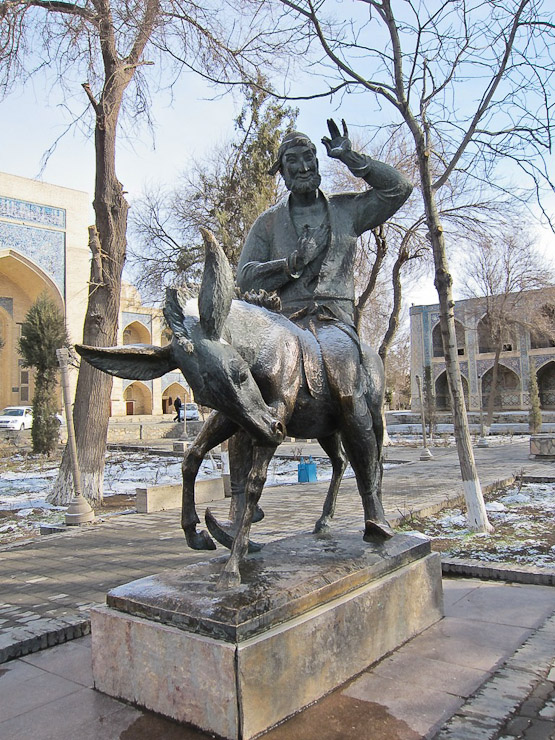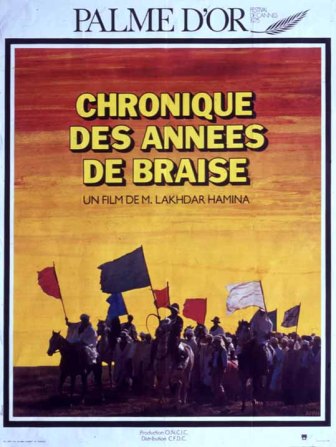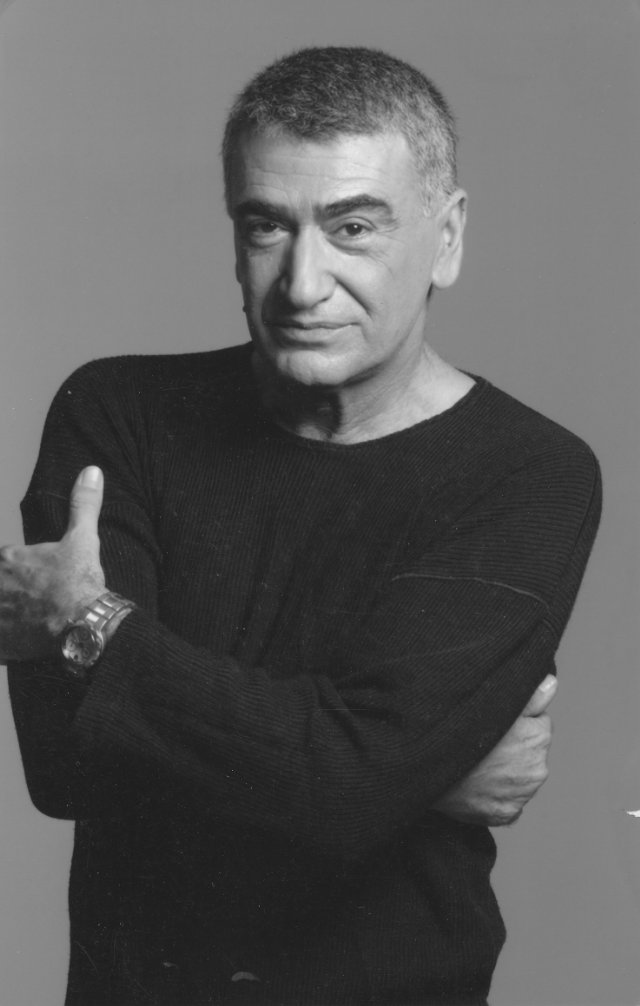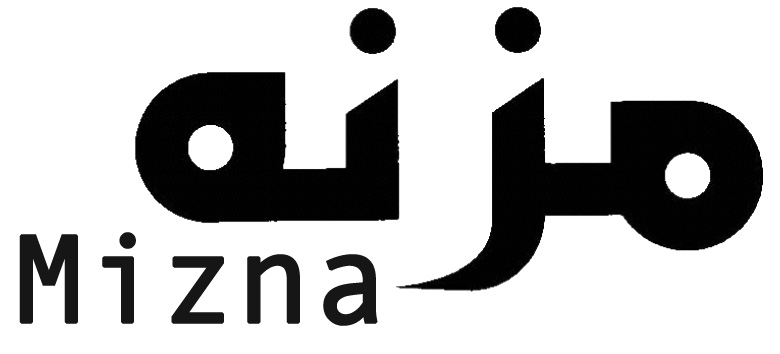Chronicle of the Years of Embers (1975): Ample Splendor, not Enough Sedition
 08-30-2013 | tagged
08-30-2013 | tagged  Algeria,
Algeria,  Algerian Revolution,
Algerian Revolution,  Algerian cinema,
Algerian cinema,  Cannes,
Cannes,  Chronicle of the Years of Embers,
Chronicle of the Years of Embers,  Mohammed Lakhdar-Hamina,
Mohammed Lakhdar-Hamina,  Palme d'Or,
Palme d'Or,  Yorgo Voyagis,
Yorgo Voyagis,  epic,
epic,  historical,
historical,  وقائع سنين الجمر |
وقائع سنين الجمر |  Post a Comment |
Post a Comment |  Email Article |
Email Article | Someone saw Nasrudin searching for something on the ground
“What have you lost, Mulla?” he asked. “My key” said the Mulla. So they both went down on their knees and looked for it.
After a while, the other man asked: “Where exactly did you drop it?”
“In my own house.”
“Then why are you looking here?”
“There is more light here than inside my own house.”1
 Nasruddin statue in Bukhara, UzbekhistaIt is said that at least seven Nasruddin tales are to be told consecutively, to lend enough time for the world’s best known wise fool tales to reduce listener resistance to the humor, long enough to open the heart to the tales’ wisdom.2 I think I ought to get around to the film’s review sooner than that!
Nasruddin statue in Bukhara, UzbekhistaIt is said that at least seven Nasruddin tales are to be told consecutively, to lend enough time for the world’s best known wise fool tales to reduce listener resistance to the humor, long enough to open the heart to the tales’ wisdom.2 I think I ought to get around to the film’s review sooner than that!
The wise fool, the jester, or the savant fool has shown up in cultures aplenty, in the histories of their royal courts as well as in their literary and/or oral tradition. In the company of monarchs and magistrates—in societies European, Islamic and Asian—the fool's principle function was to remind such societies’ monarchs of their humanity3, to check against the excessively agreeable advise conveyed by royal court sycophants, the monarchs' yes-men.
Nasrudin (also Nasruddine) if he existed at all was born in modern day Turkey it seems, around eight centuries ago. His archetype appears in a variety of cultures under a miscellany of guises, including in the Arab World as Juha.4
 Mohammed Lakhdar-HaminaMohammed Lakhdar-Hamina (محمد الأخضر حمينة) who must have known about Juha and was likely also exposed to wise fools deployed by Western European novelists and playwrights for centuries for their utility in varying the discourse and in enhancing the moral and dramatic stakes of such works. After all, what would King Lear be without its Fool. So impressed was Hamina with the wise fool that he decided to make one such character a lead and to play him himself, in Hamina’s most highly regarded film, the only African or Arab film to ever win Cannes’s top prize, the Palme d’Or—Chronicle of the Years of Embers.
Mohammed Lakhdar-HaminaMohammed Lakhdar-Hamina (محمد الأخضر حمينة) who must have known about Juha and was likely also exposed to wise fools deployed by Western European novelists and playwrights for centuries for their utility in varying the discourse and in enhancing the moral and dramatic stakes of such works. After all, what would King Lear be without its Fool. So impressed was Hamina with the wise fool that he decided to make one such character a lead and to play him himself, in Hamina’s most highly regarded film, the only African or Arab film to ever win Cannes’s top prize, the Palme d’Or—Chronicle of the Years of Embers.
So what does it take for a film to win arguably the most prestigious award in all of cinema in any given year? Well, presumably singular cinematic excellence in vision and in execution, though this has not held true every year. Consider the case of Michael Moore’s Fahrenheit 9/11, winner of the Palme d’Or in 2004, one of only three documentary films to be admitted into the competition for the top prize. It would be naïve to think the film deserving of it on artistic merit alone. How could one explain its receiving the longest standing ovation of any film in the festival’s history? Political persuasion. Half of the jury members for that year’s competition were American, Americans who probably couldn’t escape the avalanche of anti-Bush sentiment expressed at the time of the festival’s holding that year, what with the evident failure to locate WMDs in Iraq. How better to distance oneself from Bush and his doctrine than to vote for the propagandist anti-Bush cinematic tirade Fahrenheit 9/11.
Not to say that that Chronicle of the Years of Embers (also Chronicle of the Years of Fire, Chronicle of the Smoldering Years, Chronique des Années de Braise, وقائع سنين الجمر) is on par cinematically with Farenheit 9/11, only that it well stands to reason that the ten-member competition jury that year—comprising three French, including jury president Jeanne Moreau, as well as Russian director Yuliya Solntseva who had won the Best Director award in 1961 for her film (ready?) The Chronicle of the Flaming Years—would have been persuaded to award the festival’s top prize to the Algerian film. Do I merely speculate that the jury was politically motivated? Yes, but I have watched four other films in that year’s competition and would readily opine that Michelangelo Antonioni’s The Passenger and especially Werner Herzog’s The Enigma of Casper Houser are superior cinematic works.
 Chronicle of the Years of Embers like most films selected for that year’s Cannes competition and like all others by the director—he made seven of them—are exceedingly difficult to find (hearty thanks to Bob Anant for the VHS copy), though having watched two other works of his I feel that his films deserve remastering and reissuing. Not only was Hamina one of few Algerian filmmakers to produce narrative features in the 60s and 70s, but he has obviously influenced other filmmakers stylistically and conceptually, including plainly Tunisian filmmaker Nacer Khmer in his notable and noted Desert Trilogy, not least in their tactile and transportive desert photography.
Chronicle of the Years of Embers like most films selected for that year’s Cannes competition and like all others by the director—he made seven of them—are exceedingly difficult to find (hearty thanks to Bob Anant for the VHS copy), though having watched two other works of his I feel that his films deserve remastering and reissuing. Not only was Hamina one of few Algerian filmmakers to produce narrative features in the 60s and 70s, but he has obviously influenced other filmmakers stylistically and conceptually, including plainly Tunisian filmmaker Nacer Khmer in his notable and noted Desert Trilogy, not least in their tactile and transportive desert photography.
Chronicle is presented in six chapters, introduced by poorly descriptive titles: 1. The Ash Years; 2. The Ambers Years; 3. The Fire Years; 4. The Cart Years; 5. The Charging Years; 6. November 11th, 1954. As a whole, these rhapsodize about the Algerian national experience between the break out of World War II and November 11th, 1954 ten days after the launch of the Algerian Revolution, a brutal war of independence from a France that considered Algeria part of its integral territory, a revolution that would end in 1962 with the attainment of national independence.
The film's plot elides a historical narrative, naming little and few, preferring a theatrically vivified account of two Algerians, mostly occurring in an unnamed provincial town. Both figures take on mythical dimensions, both embody heroism: one speaks the Truth; the other fights for it. The former—the wise fool named Miloud (مولود), played with grandiose gusto by director Hamina—introduces the latter—the beleaguered, brawny Ahmed, played with precise control by Greek star Yorgo Voyagis—to politics of a broader scope, upon Ahmed’s arrival in the town nearest his village, thereby triggering within Ahmed a consciousness keener than had informed his struggle, his and his tribe’s, to secure water against a competing tribe in his home village. Even though Ahmed becomes a revolutionary in earnest when joining another, a leader named ‘L’arabi (العربي) upon the latter’s banished arrival in the Ahmed’s adoptive town, it is Miloud’s invocation, entreaty and, incitement that have awakened Ahmed. By film’s end, the two heroes, who will have grown close enough that Miloud is caring for the by then full-fledged revolutionary Ahmed’s son, give birth to the revolution.
 Yorgo VoyagisIt would seem suspect that such a well-funded, national production telling such a patriotic story would hire a non-Algerian actor in the role of the phoenix Ahmed. Yet it is a credit to actor and director that Vaoyagis’s performace is credible as well as creditable. Perhaps I glommed a single line of dialogue in which the actor’s lips don’t sink with his words—impressive despite the paucity of lines uttered by the laconic Ahmed, if one were to consider the obviousness of lip sinking by such superb actors as Lars Rudolph and Tilda Swinton in Werkmeister Harmonies and The Man from London respectively, as directed by the great Bela Tarr. Whereas normally I would scoff at such “ethnically workable” casting of an internationally recognized actor for the purpose of enhancing critical and commercial interest in a film, I herewith acquiesced.
Yorgo VoyagisIt would seem suspect that such a well-funded, national production telling such a patriotic story would hire a non-Algerian actor in the role of the phoenix Ahmed. Yet it is a credit to actor and director that Vaoyagis’s performace is credible as well as creditable. Perhaps I glommed a single line of dialogue in which the actor’s lips don’t sink with his words—impressive despite the paucity of lines uttered by the laconic Ahmed, if one were to consider the obviousness of lip sinking by such superb actors as Lars Rudolph and Tilda Swinton in Werkmeister Harmonies and The Man from London respectively, as directed by the great Bela Tarr. Whereas normally I would scoff at such “ethnically workable” casting of an internationally recognized actor for the purpose of enhancing critical and commercial interest in a film, I herewith acquiesced.
Other aspects of film strike me as more problematical than the casting of a Greek to play a fictional Arab. Hamina’s decision to cast not only himself but his three sons in the film reeks of nepotism, especially when considering that one’s performance as Ahmed’s son, the one that Miloud takes care of while his father is imprisoned then on the run, underwhelms, especially in the closing moments of the film. (The child actor could also have used with some darkening makeup, since he is quite lighter in complexion and hair color than any of the other Arab characters.)
More troublesome is the collusive relationship between Hamina and the Algerian government. Hamina had worked in the Information Minsitry of Provisional Government of the Algerian Republic (GPRA) in Tunis, before training with the Tunisian newsreel outfit Actualités Tunisiennes, in the late 50s. He then left for Prague where, after abandoning film studies, he wrote and co-directed three short films. Thus, upon returning to Algerian, following its declaration of independence in 1962, having surely been promoted by his connections in the exiled government, Hamina set up and took charge of Algeria’s own Newsreel Office (OAA) in 1963, which Hamina then deployed to produce his films, shorts early on then features, of which he made three by the time that the OAA had been shut down in 1974: The Wind from the Aures (ريح الأوراس from 1966—a compelling war drama and impressive first feature that garnered the award for best first feature in Cannes, setting the stage for the Chronicle’s winning of the very festival’s top prize), Hassan Terro (حسان الإرهابي from 1968, a satirical politically charged comedy) and December (ديسمبر from 1972, a drama about torture and guilt, told from a French officer’s point of view—surprisingly)5.
Meanwhile, these same feature films were produced by the “official” state film production company named Office National Commerce Industrie Cinéma (ONCIC), which would produce Hamina’s next two films, after the dissolution of OAA, Chronicle and his 1982 episodic woman centered drama Sandstorm (رياح رملية). His last film The Last Image (الصورة الاخيره from 1986) would become his only non-Algerian state production.6
 Houari BoumedieneHamina has described Chronicle of the Years of Embers as a purely personal work, not an historical one, which conveniently rebuts accusations of his having created a work to comport with the concurrent agenda of the Houari Boumedienne military dictatorship, including the government’s sanctioned version of Algerian modern history. Is it merely a coincidence that Hamina managed to produce/make his own feature narrative films after Boumedienne—who had led the “frontier army” in Tunisia during the revolution, while Hamina served there—had taken over in 1965?7 Yet, how could the film not be personal, when Hamina not only directed Chronicle and played one of its two protagonists; he also wrote the story upon which the screenplay was based, a screenplay which he co-wrote. Hamina is also credited as the picture’s sole producer and, rather comically, its camera operator! Moreover, the parallels between his own life and his character Ahmed’s experience are certainly evident.
Houari BoumedieneHamina has described Chronicle of the Years of Embers as a purely personal work, not an historical one, which conveniently rebuts accusations of his having created a work to comport with the concurrent agenda of the Houari Boumedienne military dictatorship, including the government’s sanctioned version of Algerian modern history. Is it merely a coincidence that Hamina managed to produce/make his own feature narrative films after Boumedienne—who had led the “frontier army” in Tunisia during the revolution, while Hamina served there—had taken over in 1965?7 Yet, how could the film not be personal, when Hamina not only directed Chronicle and played one of its two protagonists; he also wrote the story upon which the screenplay was based, a screenplay which he co-wrote. Hamina is also credited as the picture’s sole producer and, rather comically, its camera operator! Moreover, the parallels between his own life and his character Ahmed’s experience are certainly evident.
Hamina’s rejective defensiveness notwithstanding, I find myself unconvinced that Chronicle is a purely personal work, considering the overt historical references, the archival war footage and the publicized connection between the film’s production and the Algerian government’s celebration of the twenty year anniversary of the launch of the Algerian Revolution, which is the event that concludes the film.8
Chronicle also appears cautious about condemning France’s colonial role. Most of the depicted violence is at the hands of collaborators and apologists, particularly at the silent behest of the Caïd (سيد), the magistrate of the town to which Ahmed moves early on in the film, at the hands of his henchmen. Curiously, though we see Ahmed suddenly pick up a sword and straddle a horse (rather unconvincing, but then he is a mythical figure) in defense against a massacre perpetrated against himself and his comrades at the hands of an Algerian cavalry, a massacre that he survives, we do not see the perpetrators of a subsequent, sudden attack that brings Ahmed’s life to an end; they are neither shown nor identified in the script.
Chronicle has also been criticized for having enlisted many European technicians, including the cinematographer and composer. In the film’s defense, most medium or big budget Arab films made today still rely on non-Arab talent, including often in the two roles mentioned. Yet, considering Chronicle’s subject matter, I agree with the criticisms of the film’s having been scored by a European musical soundtrack.9
Reportedly, Algerian critics and filmmakers resented Chronicle’s cost, which would exhaust Algerian cinema’s state budget for three years.10 Nevertheless, Chronicle is an ambitious, stupendous, fitfully entrancing work, whose expense is born on the screen in splendid glory. The abundance of crane and aerial photography serves the expansive vistas, captured using 70mm Panavision from what I have gathered (recorded on 35mm film, not 70mm, as has been predominantly described, then printed onto the comparatively expensive 70mm stock for exhibition). The sizable budget in the case of Chronicle surely availed its stunning imagery, in a three-hour epic.
Considering the problems with Chronicle of the Years of Embers, it certainly deserves to be seen and discussed. Further, it deserves a thorough remastering job, one to vivify the film’s splendor. Any takers?
CHRONIQUE DES ANNEES DE BRAISE Eng sub by lakhdar-hamina
Notes:
1. Shah, Idries. The Exploits of the Incomparable Mulla Nasrudin. London: Octagon, 1983. Print. pp. 9
2. Shapiro, Ann. Preface. The Uncommon Sense of the Immortal Mullah Nasruddin. Comp. Ron J. Suresha. Maple Shade: Lethe, 2011. 7. Print.
3. Martin, Vanessa. "The Jester and the Shadow of God: Nasir al-Din Shah and His Fools." Iranian Studies 40.4 (2007): 467-81. EBSCO. Web. 29 Aug. <http://web.ebscohost.com/ehost/detail?sid=c2d850b6-6967-4713-b5e2-da2a6fde8826%40sessionmgr12&vid=1&hid=14&bdata=JnNpdGU9ZWhvc3QtbGl2ZQ%3d%3d#db=aph&AN=26461345>. pp. 467
4. See # 2. pp. 11
5. Armes, Roy. "Cinema of the Maghreb." Companion Encyclopedia of Middle Eastern and North African Film. Ed. Oliver Leaman. 2nd ed. New York: Routledge, 2004. 420-514. Print. pp. 464
6. See # 5
7. Armes, Roy. Postcolonial Images: Studies in North African Film. Bloomington: Indiana University, 2005. Print. pp. 96-104
8. See # 7
9. See # 7
